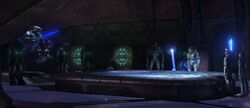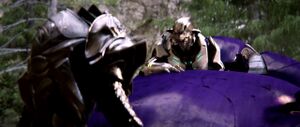Schismatics
From Halo: Daybreak
The Schismatics were the Covenant forces who stood in opposition against the Hierarchs and their loyalists in the Great Schism, or more specifically the conflict's early days. This mostly encompassed Sangheili and their allies and/or direct subordinates who remained loyal to their commanders; the term specifically refers to individuals and groups who were belligerents in the hostilities of the Schism. The UNSC tentatively referred to these forces as Covenant Separatists, though this is technically inaccurate as most of the Sangheili had no intentions to secede from the Covenant. Indeed, many of them continued to see themselves as the legitimate members of the alliance; according to this view, the San'Shyuum (or specifically the Prophet of Truth's triumvirate) had voided their membership by betraying the Writ of Union.
Definition[edit | edit source]
It should be noted that the Schismatics are more of a label used for historical convenience than a singular affiliation, as the first days of the Schism were highly confused and few to no factional lines yet existed as such.
The active agents among the Schismatics are commonly understood as mainly encompassing the Sangheili, with the lesser-ranked species typically having little choice but to continue serving their commanders. Some noticeable trends did occur, however; when given the chance, Unggoy, Huragok and Lekgolo tended to favor Sangheili commanders over Jiralhanae; Unggoy and Huragok due to the Brutes' reputation for cruelty, and Lekgolo out of historical and cultural ties. Kig-Yar loyalties were as ecletic as their species; by and large, mercenary companies and privateers fought for whoever was paying, which was in the beginning perceived as the Covenant under Truth. However, many Kig-Yar mercenaries saw Truth's power grab as the folly it was and went independent at the first opportunity. The major Yanme'e queens of High Charity aligned themselves with Truth, though in other population centers there was no clear preference. Within the Holy Ecumene, Yanme'e queens largely carried on business as usual with their political relations, though some sought to pursue greater ambitions of their own. Civilians of all species were forcibly drafted into service by both sides.

However, what tends to get less attention is that many San'Shyuum also positioned themselves against Truth. Indeed, most of the general San'Shyuum population were never privy to Truth's plans and were caught completely off guard by his announcement of the Changing of the Guard and the subsequent escalation of the situation. Truth had managed to bribe, blackmail or intimidate most of the major ministers on his side prior to the outbreak of the Great Schism, having those with known Sangheili sympathies reassigned or ousted. It has even been widely theorized that Truth would have soon moved to remove the Prophet of Regret due to the younger Hierarch's good relations with the Sangheili, as Regret may have compromised Truth's entire plan.
When the Schism broke out, Truth issued an ultimatum circulated among major San'Shyuum leaders, compelling them to remain loyal or be excommunicated. With the chaos of the Schism and the Flood outbreak on High Charity, most never received the message. Others took it as evidence Truth had gone mad, and eagerly awaited for the High Council and the Courts of High Charity to move to remove him from office. Many San'Shyuum did go along, however, either out of religious or personal conviction, or simply a disdain or distrust for the Sangheili. This, too, was relatively common among San'Shyuum in the 9th Age of Reclamation and the so-called "Ages of Complacency" that preceded it. There had been a persistent tension between the political apparatus of High Charity and the regional Sangheili nobles, which had its origins in the Second Illumination seven centuries earlier. This was in addition to the ever-growing doubts and even unrest among the Sangheili, with tensions mounting between two camps against and for the human campaign - tensions that resonated as high up as the High Council Chamber. But despite all this, few had believed Truth would go this far.
Many San'Shyuum were virtually forced to align themselves with Truth; a particular compelling factor was the replacement of many of the ministerial security forces with Tartarus' Jiralhanae, a subtle process that began years before the notorious Changing of the Guard. Still, many of the influential San'Shyuum had friends among the Sangheili and sought to covertly act against Truth. Others had no personal or political ties to the Sangheili, but liked the Jiralhanae even less. Unfortunately, such covert activities would often go unappreciated by enraged Sangheili mobs, who - in the absence of facts - often saw any San'Shyuum as being in collusion with Truth. Not all did, however. As Truth had been forced to accelerate his plans upon Regret's death, the replacement of the guards and military leadership was far from complete. One notable case were the security forces of the High Courts of the Holy City, still staffed by Sangheili. In other ministries and institutions, the replacement process was still ongoing or had not yet taken place, and the Sangheili quickly reasserted their role. This was particularly true out in the domains, where the Sangheili still predominated despite recent efforts to integrate the Jiralhanae.
History[edit | edit source]

The Sangheili-led Schismatic forces around High Charity had some level of coordination from the beginning, and some Sangheili commanders of note, such as Thel 'Vadamee and Rtas 'Vadumee attempted to gather Sangheili-led forces under their command with varying success. Within hours of the Schism's beginning, the Schismatic fleets at High Charity organized themselves under three main formations: the Fleet of Retribution commanded by Rtas 'Vadum, the Fleet of Defiance commanded by Nerit 'Mulaparthan, and the Fleet of Deliverance commanded by Nhal 'Rhanem. Known as the Ternion, this was the first pact made between the Schismatics, and would later evolved into the Singular Bond and the Concord of Reconciliation. At the spinward base-world Joyous Exultation, the highly influential Imperial Admiral Xytan Jar 'Wattinree attempted to gather an alliance of Sangheili commanders and lords to reform the Covenant under himself, but these plans quickly fell through when a NOVA bomb transported from Reach wiped out most of the Combined Fleet of Righteous Purpose and the other fleets assembled over Joyous Exultation. This event is widely cited as having cemented the Ternion's and later Singular Bond's predominance in shaping the politics of the Schismatics.
Out within the Covenant Sphere, the news of the Schism only reached some domains days, weeks or even months later. Far in the marches of the Covenant's trailing quarter, the Imperial Admiral Gervul Jar 'Shaol commanded the Combined Fleet of Boundless Obeisance. Though news of the Schism reached him with a delay, the Imperial Admiral managed to secure deals with several key worlds which strengthened his position relative to the Singular Bond.
While the fall of High Charity created a wave of unrest that swept throughout the Covenant Empire, the immediate consequences of the Schism were not always bloody. However, large parts of the galactic spinward side of the Holy Ecumene in particular continued to see heavy fighting between the Sangheili and Jiralhanae for years to come. In some cases, the local authorities successfully managed to cover up knowledge of the Great Schism for a time, even for several years, though in the long run this would be futile as news spread by traders and migrants and the economic effects of the fall of the holy city reached even the furthest corners of the Covenant Empire.
Though various San'Shyuum and Jiralhanae leaders claimed succession to the Covenant proper, this was widely contested, and the rise of more defined polities out of both the Schismatics and Covenant loyalists prompted most historians to refer to those polities instead for reasons of clarity. However, commentators have continued to use the Schismatic label in reference to events set as late as the mid-2560s, typically in the context of the ongoing Sangheili-Jiralhanae conflict. The largest and most continuously stable polity to come out of the Schismatics is the Concord of Reconciliation. Initially encompassing a collection of Sangheili commanders operating in the Human Sphere as well as those of the initial Ternion, the Concord successfully unified many of the provincial polities formed during the Schism, and even reestablished relations with the Covenant's political remnants at the Strewn Shore in the post-war years.


